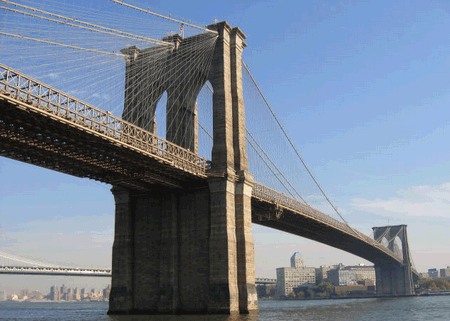
Another of the many paradoxes that inform New York City history is the romance that is synonymous with the Brooklyn Bridge. Certainly, its grace is undeniable and neither the Manhattan nor the Williamsburg Bridges can equal it. On the other hand, though, the practical justification for a bridge cheek by jowl next to the Fulton Ferry was to increase passenger traffic between the two cities and hasten Brooklyn’s amalgamation in 1898 into what New York’s late-1960s mayor John Lindsay would call the ungovernable monolith of Greater New York (primarily because he could not govern it).
From the perspective of a New Yorker writing in the early years of the twenty-first century, the random pattern of events seems perfect and planned. The 1850s brought massive Irish immigration to New York. Many of those who came through the Castle Garden immigration station down at the Battery necessarily lived in the city of Brooklyn. Many of those living on teeming Mulberry Street worked in the city of Brooklyn. Officials of both cities recognized the obvious need for easier communication between Brooklyn and Manhattan; hence, the commission they granted the German immigrant John Augustus Roebling in 1861 to conduct preliminary surveys on the feasibility of a suspension bridge over the East River at or near Fulton Street.
Roebling thus starts his work even as Frederick Law Olmstead and Calvert Vaux begin to design Central Park and eliminate by force of law the shanty-town that unemployed Irish immigrants had established for themselves at Lookout Rock, just inside the 59th Street entrance to the park. The Civil War gave some unwanted employment to many Irish immigrants, as Union soldiers, since most could not afford the $300 they needed to purchase a surrogate. Forced military service via a draft lottery spawned the draft riots in 1863.
After 1870, immigration resumes with a vengeance. Italians join the Irish as a second massive wave. They, too, reside in the overcrowded Lower East Side community which comes to be called Little Italy, and they also walk the Brooklyn Bridge to work in the Brooklyn shipyards or on its waterfront. Is it any wonder, then, that St. John’s College takes on the name resigned by a Bronx Jesuit institution that started calling itself Fordham? Is it so surprising that when Emily Roebling, widow of John Augustus’s son George Washington Roebling, finishes the construction of the Brooklyn Bridge in 1883, the little Roman Catholic Brooklyn college on Lewis Avenue has three hundred young Irish and Italian men on its register?
These young Brooklynites would raise their families in Brooklyn; they would become professionals and implicitly challenge the status quo ante bellum. They might, on special occasions, even have $0.75 or $1.50 to attend (admittedly in the upper reaches of the house), a performance of the Metropolitan Opera Company, whose great yellow-brick building, designed by Joseph Cleveland Cady, had risen at Broadway and 39th Street in the very year P.T. Barnum marched his elephant herd across the just opened Brooklyn Bridge to prove its strength. A century and a quarter later, it appears that Barnum was right, about the bridge and about New York.
From the perspective of a New Yorker writing in the early years of the twenty-first century, the random pattern of events seems perfect and planned. The 1850s brought massive Irish immigration to New York. Many of those who came through the Castle Garden immigration station down at the Battery necessarily lived in the city of Brooklyn. Many of those living on teeming Mulberry Street worked in the city of Brooklyn. Officials of both cities recognized the obvious need for easier communication between Brooklyn and Manhattan; hence, the commission they granted the German immigrant John Augustus Roebling in 1861 to conduct preliminary surveys on the feasibility of a suspension bridge over the East River at or near Fulton Street.
Roebling thus starts his work even as Frederick Law Olmstead and Calvert Vaux begin to design Central Park and eliminate by force of law the shanty-town that unemployed Irish immigrants had established for themselves at Lookout Rock, just inside the 59th Street entrance to the park. The Civil War gave some unwanted employment to many Irish immigrants, as Union soldiers, since most could not afford the $300 they needed to purchase a surrogate. Forced military service via a draft lottery spawned the draft riots in 1863.
After 1870, immigration resumes with a vengeance. Italians join the Irish as a second massive wave. They, too, reside in the overcrowded Lower East Side community which comes to be called Little Italy, and they also walk the Brooklyn Bridge to work in the Brooklyn shipyards or on its waterfront. Is it any wonder, then, that St. John’s College takes on the name resigned by a Bronx Jesuit institution that started calling itself Fordham? Is it so surprising that when Emily Roebling, widow of John Augustus’s son George Washington Roebling, finishes the construction of the Brooklyn Bridge in 1883, the little Roman Catholic Brooklyn college on Lewis Avenue has three hundred young Irish and Italian men on its register?
These young Brooklynites would raise their families in Brooklyn; they would become professionals and implicitly challenge the status quo ante bellum. They might, on special occasions, even have $0.75 or $1.50 to attend (admittedly in the upper reaches of the house), a performance of the Metropolitan Opera Company, whose great yellow-brick building, designed by Joseph Cleveland Cady, had risen at Broadway and 39th Street in the very year P.T. Barnum marched his elephant herd across the just opened Brooklyn Bridge to prove its strength. A century and a quarter later, it appears that Barnum was right, about the bridge and about New York.

No comments:
Post a Comment